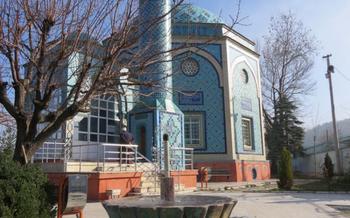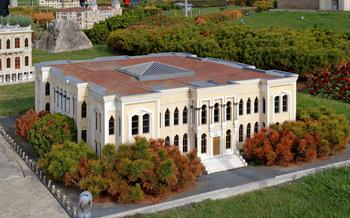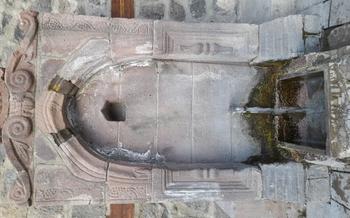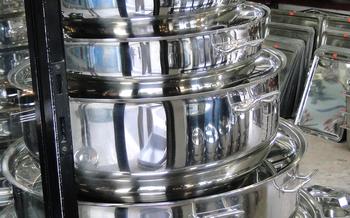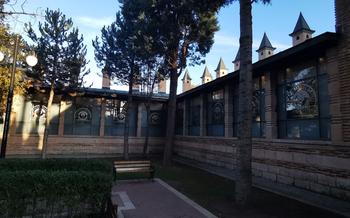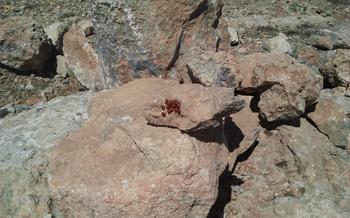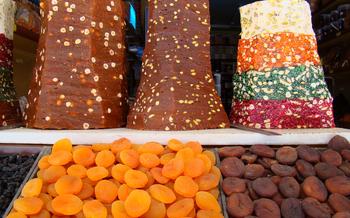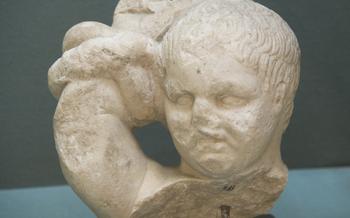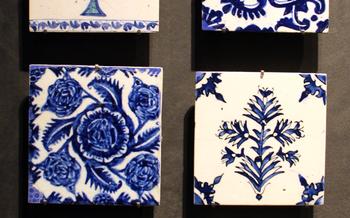
Kütahya Glass Museum
- The Antiquity of Kütahya Pottery
- The Establishment of the Kütahya Glass Museum
- The Museum's Collection
- Interactive Displays and Exhibitions
- The Museum's Architecture and Design
- Guided Tours and Accessibility
- The Museum's Contribution to Cultural Tourism
- The Museum as a Research Center
- The Museum's Outreach Programs
- The Museum Shop and Café
- Museum's Recognition and Awards
- The Museum's Publications and Documentation
- The Museum's Future Plans and Initiatives
- Insider Tip:
The Antiquity of Kütahya Pottery
Kütahya, a city nestled in western Turkey, boasts a rich history of pottery that dates back to the Hittites, one of the earliest civilizations in Anatolia. The Hittites were renowned for their exquisite pottery, characterized by intricate patterns and vibrant colors. Over the centuries, Kütahya's pottery tradition continued to flourish under the influence of Seljuk and Ottoman artisans, who brought their unique artistic styles and techniques to the craft.
Seljuk artisans, known for their mastery of glazed ceramics, introduced new decorative motifs and color palettes to Kütahya pottery. Their influence is evident in the vibrant blues, greens, and turquoise that adorn many of the ceramic pieces from this period.
The Ottoman era marked a golden age for Kütahya pottery. During this time, the city became a renowned center for ceramic production, supplying the imperial court and wealthy patrons throughout the empire. Ottoman artisans developed innovative techniques, such as the cuerda seca method, which involved applying wax resist to create intricate designs on the pottery. The resulting pieces were highly prized for their beauty and craftsmanship.
Kütahya pottery is distinguished by its unique characteristics and techniques. The clay used in Kütahya is of exceptional quality, known for its fine texture and rich color. Artisans employ a variety of firing techniques to achieve different effects, from the brilliant luster of glazed pottery to the earthy tones of unglazed terracotta. The intricate designs and patterns are often inspired by traditional Turkish motifs, such as floral patterns, geometric designs, and calligraphy.
Kütahya pottery holds a special place in Turkish cultural heritage, representing a centuries-old tradition of craftsmanship and artistic expression. The city's pottery has been recognized for its exceptional quality and beauty, earning it a reputation as one of Turkey's most significant centers of ceramic production.
The Establishment of the Kütahya Glass Museum
The Kütahya Glass Museum, a testament to the city's rich glassmaking heritage, owes its existence to a remarkable collaboration between the Kütahya Municipality and a dedicated team of experts in the field. Recognizing the significance of preserving and showcasing Kütahya's unique glass art tradition, the municipality took the initiative to establish a museum that would serve as a center for the celebration, study, and appreciation of glass art.
The museum's strategic location in the heart of Kütahya, a city steeped in history and culture, further enhances its mission. Situated in a beautifully restored historical building, the museum is easily accessible to visitors from around the world. This central location not only provides convenience but also allows the museum to play a vital role in promoting cultural tourism and revitalizing the city's historic core.
With a clear mission to preserve and promote Kütahya's glassmaking heritage, the museum also embraces a forward-looking vision. It aims to be a dynamic and innovative institution, constantly evolving to meet the changing needs of visitors and the ever-evolving world of glass art. Through its diverse collection, interactive displays, and educational programs, the Kütahya Glass Museum strives to inspire, educate, and captivate audiences of all ages, fostering a deeper appreciation for the art of glassmaking and its enduring legacy.
The Museum's Collection
The Kütahya Glass Museum houses a diverse collection of glass objects that showcase the rich history and artistry of glassmaking in Kütahya. The collection spans various periods, from ancient to contemporary, encompassing a wide range of techniques, styles, and designs.
Visitors can admire exquisite examples of traditional Kütahya pottery, renowned for its intricate patterns, vibrant colors, and unique glazing techniques. The museum also features a collection of Islamic glass objects, including delicate lamps, intricate bottles, and decorative tiles, reflecting the region's rich cultural heritage.
The museum's collection includes works by renowned glass artists, both from Turkey and around the world. These contemporary pieces push the boundaries of glass art, showcasing innovative techniques and unconventional forms, providing a glimpse into the evolving world of glass artistry.
The Kütahya Glass Museum is dedicated to preserving and documenting this remarkable collection. Through meticulous research and conservation efforts, the museum ensures that these glass objects remain accessible to the public, serving as a valuable resource for scholars, artists, and enthusiasts alike.
Interactive Displays and Exhibitions
The Kütahya Glass Museum offers a dynamic and immersive experience through its interactive displays and exhibitions. Multimedia presentations and touchscreens provide visitors with in-depth information about the history, techniques, and significance of glass art. Virtual reality stations allow visitors to explore glassmaking processes and experience the artistry firsthand.
Temporary exhibitions showcase contemporary glass art, featuring the works of renowned artists from Turkey and around the world. These exhibitions highlight innovative techniques, styles, and trends in glass art, providing visitors with a glimpse into the ever-evolving world of this fascinating medium.
The museum also hosts regular workshops and demonstrations, allowing visitors to engage in hands-on experiences and learn from skilled glass artisans. These workshops cover various techniques, from traditional glassblowing to contemporary fusing and casting methods, providing a unique opportunity for visitors to explore their own creativity and discover the intricacies of glassmaking.
Educational programs are offered for students and the general public, aiming to foster an appreciation for glass art and raise awareness of its cultural and historical significance. These programs include guided tours, lectures, and interactive workshops, tailored to different age groups and interests. The museum's commitment to education and outreach ensures that future generations can continue to appreciate and contribute to the rich tradition of glass art in Kütahya.
The Museum's Architecture and Design
The Kütahya Glass Museum is housed in a striking contemporary building that seamlessly blends traditional and modern elements. Designed by renowned architect Emre Arolat, the museum's unique architectural features are a testament to the city's rich cultural heritage and its embrace of innovation.
The building's exterior is characterized by its clean lines and minimalist aesthetic, creating a striking contrast against the historical backdrop of the city center. The façade is adorned with intricate glass panels that reflect the sunlight, casting a mesmerizing glow on the surrounding streets.
Inside, the museum's spacious galleries are flooded with natural light, thanks to the extensive use of glass throughout the building. This not only enhances the visitor experience but also provides the perfect ambiance to showcase the delicate glass objects on display.
The museum's design seamlessly integrates traditional Turkish motifs and patterns into its contemporary architecture. This fusion of old and new is evident in the intricate tile work, decorative arches, and geometric designs that adorn the building's interior.
The Kütahya Glass Museum is a true masterpiece of architectural design, showcasing the city's commitment to preserving its cultural heritage while embracing modern trends. Its unique features make it not only a repository of glass art but also a work of art in its own right.
Guided Tours and Accessibility
The Kütahya Glass Museum offers guided tours in multiple languages, ensuring that visitors from around the world can delve into the intricacies of glass art and the museum's collection. Knowledgeable guides provide insights into the history, techniques, and cultural significance of the exhibits, bringing the museum's treasures to life.
The museum is committed to inclusivity and providing a welcoming environment for all visitors. Ramps, elevators, and audio guides are available to facilitate accessibility for individuals with disabilities, ensuring that everyone can enjoy the museum's offerings. The museum's staff is always ready to assist visitors with any special needs, creating a comfortable and enriching experience for all.
The Museum's Contribution to Cultural Tourism
The Kütahya Glass Museum plays a crucial role in promoting the city's rich cultural heritage to tourists from around the world. As a leading cultural institution, the museum attracts a diverse audience interested in exploring the history, techniques, and artistry of glassmaking. The museum collaborates with local businesses, such as hotels, restaurants, and tour operators, to develop comprehensive cultural tourism packages that include visits to the museum, guided tours of the city's historical sites, and opportunities to experience traditional Turkish crafts and cuisine. The museum's strategic location in the city center further enhances its accessibility and contributes to the revitalization of the surrounding area.
The museum's commitment to cultural tourism has had a significant economic impact on Kütahya. By attracting tourists and extending their stay in the city, the museum generates revenue for local businesses, supports employment opportunities, and contributes to the overall economic development of the region. Moreover, the museum's educational programs and outreach initiatives help raise awareness of Kütahya's glassmaking heritage, fostering a sense of pride among the local community and encouraging visitors to become cultural ambassadors for the city.
The Museum as a Research Center
The Kütahya Glass Museum is not only a place of exhibition and appreciation but also a hub for research and scholarship. The museum collaborates with universities, research institutions, and individual scholars to advance the study of glass art and history. Researchers have access to the museum's extensive collection, library, and research facilities, fostering a vibrant intellectual community. The museum also hosts conferences, symposia, and workshops, bringing together experts from around the world to exchange knowledge and ideas. Through these initiatives, the museum contributes to the advancement of scholarship in the field of glass art and helps to shape the future of the discipline.
The Museum's Outreach Programs
The Kütahya Glass Museum extends its influence beyond its physical walls through a range of outreach programs, fostering a vibrant connection with the local community and visitors alike. These initiatives are driven by a commitment to promote glass art education, foster cultural appreciation, and create opportunities for engagement.
The museum organizes lectures, workshops, and exhibitions that cater to diverse audiences. Renowned glass artists, historians, and experts are invited to share their knowledge and insights, offering participants a deeper understanding of the intricacies of glass art. Workshops provide hands-on experiences, allowing individuals to experiment with various glassmaking techniques and create their own unique pieces.
Educational programs are tailored to students of all ages, introducing them to the fascinating world of glass art. Interactive activities, guided tours, and hands-on demonstrations spark their curiosity and ignite a passion for the craft. The museum's outreach programs also extend to the wider community, fostering a sense of ownership and pride in Kütahya's rich glassmaking heritage.
Through these initiatives, the Kütahya Glass Museum serves as a catalyst for cultural exchange, promoting understanding, and appreciation for the art of glass. It empowers individuals to engage with this ancient craft, fostering creativity, and preserving the legacy of Kütahya's glassmaking traditions for generations to come.
The Museum Shop and Café
The Kütahya Glass Museum offers a range of souvenirs and publications related to glass art in its gift shop. Visitors can purchase unique and handcrafted glass pieces, including decorative items, jewelry, and tableware. The shop also stocks books, catalogs, and postcards featuring the museum's collection and the history of glassmaking in Kütahya.
The museum also has a cozy café where visitors can relax and enjoy refreshments while admiring the breathtaking views of the city. The café offers a selection of hot and cold beverages, light meals, and delicious pastries. Whether you're looking for a quick snack or a leisurely lunch, the café provides the perfect setting to soak in the museum's ambiance.
The revenue generated from the museum shop and café contributes to supporting the museum's ongoing operations and educational programs. By making a purchase or enjoying a cup of coffee at the café, visitors not only get to take home a piece of Kütahya's glass art heritage but also contribute to the museum's sustainability and growth.
Museum's Recognition and Awards
The Kütahya Glass Museum has garnered widespread recognition and prestigious awards for its outstanding contributions to the field of glass art. It has been celebrated as a leading institution dedicated to preserving and promoting the rich heritage of glassmaking in Kütahya and Turkey as a whole. The museum's commitment to excellence, innovative exhibitions, and educational programs has earned it accolades from both national and international organizations.
Among the notable awards received by the museum are the prestigious "Turkish Museum of the Year Award" and the "European Museum of the Year Award." These accolades recognize the museum's exceptional achievements in showcasing the history, techniques, and cultural significance of glass art. The museum's dedication to preserving and documenting the craft has also been acknowledged through awards such as the "Cultural Heritage Protection Award" and the "Glass Art Preservation Award."
The recognition and awards bestowed upon the Kütahya Glass Museum serve as a testament to its dedication to preserving and promoting glass art. The museum's commitment to excellence and innovation has earned it a reputation as a leading institution in the field, attracting visitors and scholars from around the world. The museum's contributions to the cultural landscape of Turkey and the global glass art community have been widely recognized and celebrated.
The Museum's Publications and Documentation
The Kütahya Glass Museum is committed to documenting and preserving the history and legacy of glass art through its extensive publications and documentation efforts. The museum's publications include comprehensive catalogs that accompany each exhibition, providing detailed information about the featured glass objects, their historical and cultural context, and the techniques used in their creation. These catalogs serve as valuable resources for scholars, researchers, and enthusiasts alike, offering insights into the diverse world of glass art.
In addition to exhibition catalogs, the museum also publishes books and research papers that explore various aspects of glass art history, techniques, and conservation. These publications often feature contributions from leading experts in the field, providing in-depth analysis and new perspectives on the subject. The museum's dedication to research and documentation has established it as a leading institution in the field of glass art, contributing to the dissemination of knowledge and understanding of this fascinating art form.
The Museum's Future Plans and Initiatives
The Kütahya Glass Museum is constantly evolving and looking towards the future to enhance its offerings and impact. Among its plans and initiatives are:
-
Expanding the Collection: The museum aims to continue acquiring new and significant glass objects to enrich its collection and represent the diverse history and techniques of glassmaking.
-
Curating Special Exhibitions: The museum plans to organize temporary exhibitions that showcase the works of contemporary glass artists, explore specific themes or periods in glass art history, and promote emerging talent.
-
Educational Outreach: The museum is committed to expanding its educational programs, offering workshops, lectures, and demonstrations to students, artists, and the general public. These programs aim to foster appreciation for glass art, encourage creativity, and share knowledge about the craft.
-
International Collaborations: The museum seeks to establish partnerships with other glass museums and institutions worldwide to facilitate cultural exchange, research collaborations, and joint exhibitions.
-
Digital Initiatives: The museum is exploring the use of technology to enhance the visitor experience, including virtual tours, online exhibitions, and interactive educational resources.
-
Sustainability: The museum is committed to operating in an environmentally sustainable manner, reducing its carbon footprint, and promoting green practices in its operations and exhibitions.
Through these initiatives, the Kütahya Glass Museum strives to remain a dynamic and relevant institution, contributing to the preservation, appreciation, and advancement of glass art.
Insider Tip:
-
Best time to visit: To avoid the crowds, plan your visit to the Kütahya Glass Museum during weekdays, especially in the morning hours. This will allow you to have a more intimate experience with the exhibits and take your time exploring the museum.
-
Photography: To capture stunning photos of the glass exhibits, position yourself strategically to take advantage of the natural light filtering through the windows. Use a tripod for stability and adjust your camera settings to minimize glare and reflections.
-
Nearby attractions: After visiting the museum, take a stroll through the historic Kütahya Castle, located just a short walk away. Explore the ancient walls, admire the panoramic city views, and immerse yourself in the rich history of Kütahya.
